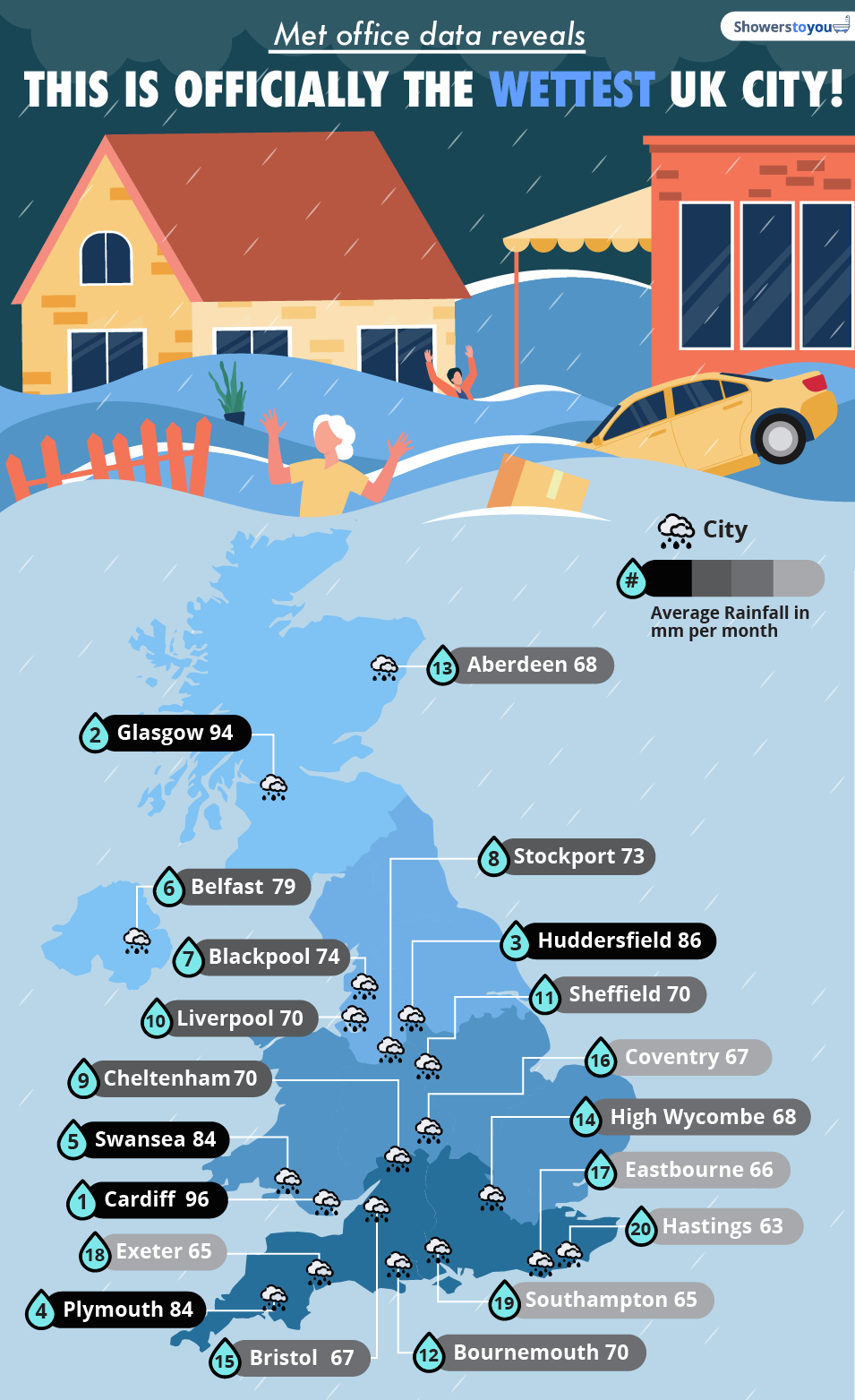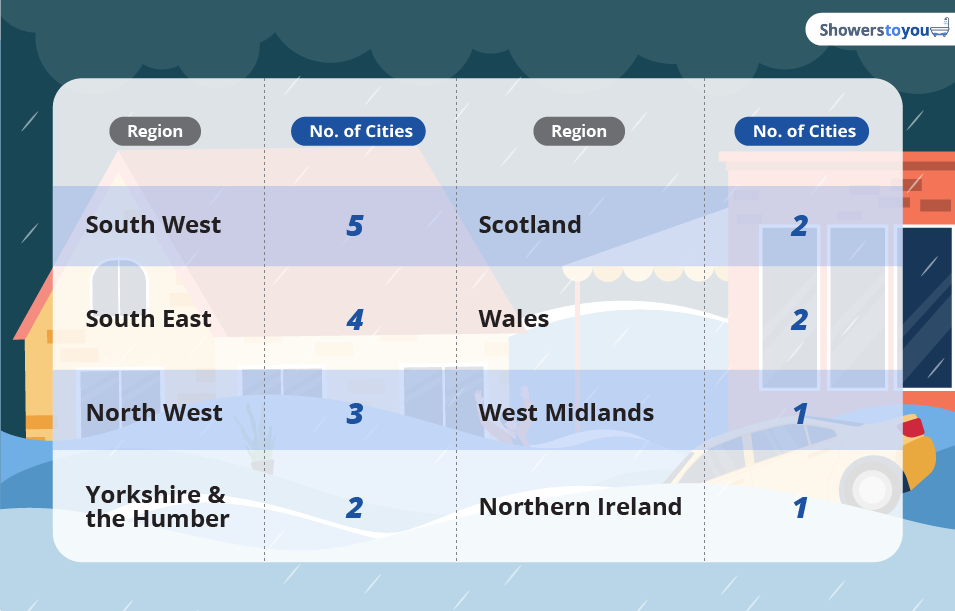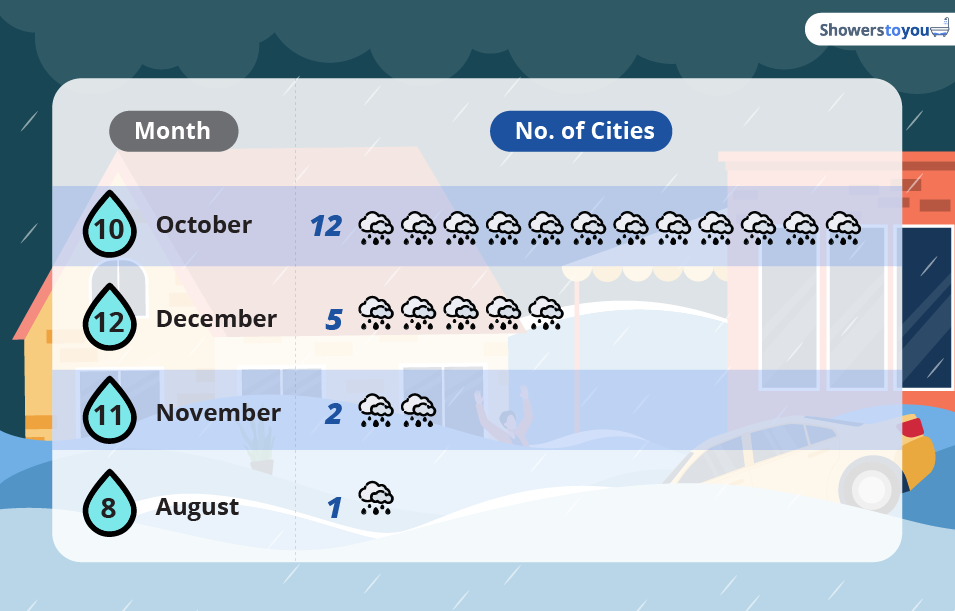UK weather is known for being unpredictable but one thing you can always expect here is rain, but which cities in the UK have it the worst? To reveal which UK city is the wettest once and for all, we analysed Met Office data.
OUR RESEARCH
We took the average amount of annual rainfall for each city in the UK that had a population of over 100,000 and divided it by 12 to find the average amount of rainfall each month. Similarly, the annual number of days of rainfall for each city was divided by 12, to find out the monthly average of days of rainfall.
WHICH UK CITIES ARE THE WETTEST?

Upholding Wales’ bad weather reputation and taking the title of the rainiest UK city is Cardiff, with an average of 96mm of rainfall each month – the most out of all the cities. People living here can expect an average of 12.4 days of rain each month.
Following closely behind is the Scottish city of Glasgow, with an average of 94mm of rain falling monthly. If you’re considering a move here, brace yourself as you can expect it to rain for an average of 14.2 days each month – the most of all UK cities analysed in our study.
In third place is Huddersfield with 10mm less rainfall each month compared to Glasgow in second (86mm). Our analysis can reveal that residents living here can expect it to rain for at least 12.8 days each month.
Following behind are Plymouth and Swansea, in fourth and fifth place respectively. Both cities join the 80mm+ of rainfall range, as both average 84mm of rainfall each month. Similarly, residents in both of these cities can expect 11.8 and 12.3 days of rain each month on average, respectively.
A number of cities were found to be in the 70mm+ range, starting with Belfast (79mm), Blackpool (74mm) and Stockport (73mm), in sixth, seventh and eighth spot.
Cheltenham, Liverpool, Sheffield and Bournemouth were all found to share an average of 70mm of rainfall each month. However, what differentiates them from each other is the average number of days of rainfall in each city. Cheltenham residents can expect 12.1 days of rainfall per month, Liverpudlians are likely to face 12 days of rain, citizens of the Steel City (Sheffield) are likely to face 11 days of rain, and those living by the coast in Bournemouth can forecast rain for 10 days of the month.
Following behind in 13th is Aberdeen and High Wycombe come in 14th, with both averaging 68mm of rain each month. However, when it comes to rainy days, Aberdeen beats High Wycombe by one extra day, with Aberdeen averaging 11.6 days each month and High Wycombe 10.9.
Also falling into the 60mm+ bracket is Bristol, with the city coming in 15th place with 67mm of rain falling each month. Coventry follows behind with 66mm of rainfall each month in 16th place. Both of these cities can expect almost 11 days of rainfall each month on average. In fact, residents of the South Western city of Bristol can expect an average of 10.5 days of rainfall each month on average, and Coventry 10.9 days.
With 66mm of rain each month, Eastbourne comes in 17th. Following closely behind with 65mm of rainfall is Exeter and Southampton. Our research can reveal that Exeter averages around 10.1 days of rain every month, on average, whereas Eastbourne and Southampton can expect 9.6 days.
Of the top 20 wettest cities in the UK, the seaside town of Hastings is the “driest”. Residents in the East Sussex town can expect 63mm of rainfall each month – 33mm less than Cardiff in first place – and an average of 9.6 rain-filled days each month.
WHICH REGION IS THE RAINIEST IN THE UK?

Taking the lead as the rainiest UK region is the South West of England, with five cities (Plymouth, Cheltenham, Bournemouth, Bristol and Exeter) deemed the wettest areas of the UK and in the top 20.
In second place with four cities making up the top 20 is the South East of England. Representing this region from the top 20 are High Wycombe, Eastbourne, Southampton and Hastings.
With three cities and in third place is North West England, as Blackpool, Stockport and Liverpool make the top 20.
Yorkshire and the Humber have only two cities in the top 20 – Huddersfield and Sheffield. Similarly, only two cities represent Scotland (Glasgow and Aberdeen) and Wales (Cardiff and Swansea) too.
The West Midlands joins in fifth place with its one representative being Coventry. Northern Ireland also has one city representing them in the top 20 – their capital city, Belfast.
WHICH MONTH IS THE RAINIEST IN THE UK?

Our research found that some months we are most likely to see rain more often than others. To find out which month in the rainest, we analysed the data to find each city’s heaviest month of rainfall.
Taking the lead is October with 12 of the top 20 cities having their heaviest amount of rainfall in this month. This should come as no surprise as Autumn is known to be one of the UK’s wettest seasons.
The 12 cities with the heaviest rainfall fall into October are Glasgow, Swansea, Belfast, Blackpool, Stockport, Cheltenham, Liverpool, Bournemouth, Aberdeen, Eastbourne, Exeter and Hastings.
December is the second most popular month for rainfall when looking at each city’s heaviest month of rainfall. We found that five cities in the top 20 had the highest levels of rainfall in the twelfth month: Cardiff, Huddersfield, Plymouth, Sheffield and Bristol.
We found that November is the third rainiest month across UK cities with both High Wycombe and Southampton having their heaviest rainfall on average during this month.
However, of the wettest cities in the top 20, August was found to be the least rainy month, as only Coventry can expect to have their heaviest downpour then.
As we can see from our findings, unsurprisingly the autumn and winter months are when the most amount of rainfall can be expected when living in the UK.
METHODOLOGY:
1. ShowersToYou.co.uk used data from the Met Office to find the average annual rainfall in mm for each UK city with a population over 100,000. Up and averaged the results to find each UK city’s average amount of rainfall each month.
2. The total number of days of rainfall was also taken and divided by 12 to find the average number of days it rains in each of the cities.
3. The numbers were then sorted from highest to lowest and the top 20 cities were taken.
4. Only cities with weather stations within 5 metres and belonging to that city were considered in this study.
Feature image credit: Fototaras / Shutterstock
